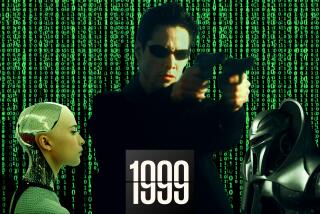Picture This: a Society at a Loss for Words
- Share via
Shortly before quaffing his hemlock cocktail, Socrates whined to Plato that this newfangled thing called “writing” would ruin clear thought. “The discovery of the alphabet will create forgetfulness in the learners’ souls,” he complained. “You will give your disciples not truth but the semblance of truth. . . . They will appear to be omniscient and will generally know nothing.”
Odds are that Socrates would have been even less enchanted with television.
There is little question that our media shape our culture--and no question that we’re shifting from a culture built on words to one based on images. Figuring for media-hype inflation, a picture’s worth 10,000 words these days and a film clip is worth even more. Words are now those things that simply link up the images; a complement to communication, not a focus. Movies and videos--not speeches and texts--determine cultural literacy.
As “power tools for thought,” as the folks at International Business Machines and Apple Computer like to brag, it’s fashionable to think that computers will inspire a new level of literacy. They will--but not in the classical sense. The most exciting work in computer science today is in the realm of visualization: the computer-enhanced visual representation of products and processes. In other words, interacting with computers in the future will be more like editing Bugs Bunny cartoons (or “Fantasia”) than reading a collection of George Orwell essays. Words will recede further in importance as computer technology transitions us from the moving image to the manipulable image.
“We speak (and hear)--and for 5,000 years have preserved our words,” notes the National Science Foundation report on scientific visualization. “But, we cannot share vision. To this oversight of evolution we owe the retardation of visualization compared to language. Visualization by shared communication would be much easier if each of us had a cathode ray tube in the forehead.”
While the NSF isn’t yet proposing that we rivet high-definition TV monitors into people’s skulls, the agency is understandably enthusiastic about the advances made in the hardwares and softwares of scientific visualization. The full-color, digitally turbocharged renderings of the brain and the body for medical diagnostics are stunning. The computer-generated eddies and swirls of mathematically manipulable visualizations of fluid dynamics are hypnotic. High-resolution simulations of cosmic clouds and black holes are as compelling as any image array put to celluloid by a Kubrick or a Spielberg.
“Computer visualization is more than just making images with computers, “it is a radically new way of thinking ,” says Richard Friedhoff in his newly published book, “Visualization.”
“It’s not that we’re using this just to make pretty pictures,” says David Salzman, head of research at Princeton’s John von Neumann National Supercomputer Center, who has worked closely with the NSF’s visualization initiatives. “If scratch and sniff had the bandwidth, we’d use that. The whole idea is to better position people in the loop. You wouldn’t play 20 Questions by submitting your questions in advance; you’d lose the subtleties of intuition. But that’s what computers now require you to do in visualizations. We want to change that.”
It’s the difference between watching a lecturer and conversing with him.
“The far more interesting, promising and inviting aspect,” Salzman continues, “is the hope that visualization holds out for fundamentally changing the nature of the conversation between the user and the machine.”
Those conversations will be in a vocabulary of images, not words. In effect, the sort of literacy that computers will demand will be visual. This is increasingly true in the sciences--currently the cutting edge of visualization applications.
“People will not show up at scientific conferences these days without some dramatic visualizations to show,” says Tom DeFanti, co-director of the Electronic Visualization Laboratory at the University of Illinois at Chicago. “The expectations of communication are rising. Eventually, scientists are going to do (visualization) just as comfortably as they do word processing.”
Just as it has in every other facet of computing, what’s being used in the scientific research community today will slip into the mainstream tomorrow. As computer processing speeds increase, as memory costs decline and a new generation of high-resolution monitors replace the Etch-a-Sketch-quality screens on today’s desks, visualization stands to become the fastest-growing and conceptually influential application in the personal computing field.
“Visualization is going to enfranchise a very large class of professionals,” Princeton’s Salzman asserts, “who will then have access to databases, simulations, games, entertainments and methods of communication in ways they hadn’t thought possible.”
As that happens, the metaphor for computing and thought will be The Image--not The Word or The Number. Doubt that? Try doing a business presentation today that doesn’t include a sheaf of Lotus 1-2-3 spreadsheet printouts. Or a marketing report that isn’t laid out and laser printed with the help of desktop publishing software. The memo of the future will look more like an MTV video than anything spawned by a LaserWriter.
The movies sparked our infatuation with the moving image, and television refueled it. Computers are moving us into a post-visual, post-literate culture where the interactive story board will be the media metaphor of choice. In some respects, fluency in animation will become the essential part of a new cultural literacy.
The rise of interactive visualization won’t kill off language and clear expression any more than television has killed books or magazines. But, just as television has had a corrupting and corrosive impact on many aspects of the public dialogue, visualization and manipulable imagery are likely to further undermine the value of spoken and written language.
For people excited by the opportunities of expressing huge masses of complex data in a radically accessible form, visualization represents a tremendous potential. For people who care deeply about language and expression, visualization is another sharp nudge on the slippery slope to the new inarticulateness. We are moving to a time when people will grope for the right image before they grope for the right word. It would be nice if computers could help society strike a better balance between language and image. The odds are they won’t.






